Not all Sparkling Wines are Created Equal!
February 8, 2012
There are about 5 different ways to give a wine its "sparkle". The methods range from the most simple: carbonation (like they do with soda), right the way through to the method we’re about to discuss.
Méthode Champenoise or Méthode Traditionnelle (Champagne Method) is easily the most time-consuming, but arguably yields the highest quality result. It’s also the oldest and most traditional way to make a wine “bubbly”.
History boffins are a little confused as to who exactly invented "the Champagne Method". For the longest time it was assumed that Dom Perignon (a Benedictine Monk) invented Champagne, around 1698. In England however, Sir George Etheredge made mention of sparkling wine as early as 1676. I’ll take George’s side on this one, but then again, I’m a little biased…
How to Make Champagne….Should You Feel the Need…
(I would like to state for the record that I’ve done my very best to make this all as straight-forward and entertaining as possible; however we’re dealing with winemaking….which for the most part is neither of those things.)
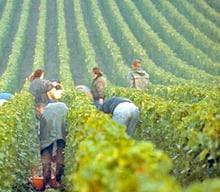 1. The grapes used in sparkling wines are typically a blend of Chardonnay, Pinot Noir, and Pinot Meunier (these 3 are the grapes of true Champagne i.e. no other grapes are allowed to be part of the blend). The grapes used to make sparkling wine are grown in the same way as any other grape. Come harvest, the grapes are picked. Harvesting and sorting of grapes is still done by hand, at least in the Champagne region of France.
1. The grapes used in sparkling wines are typically a blend of Chardonnay, Pinot Noir, and Pinot Meunier (these 3 are the grapes of true Champagne i.e. no other grapes are allowed to be part of the blend). The grapes used to make sparkling wine are grown in the same way as any other grape. Come harvest, the grapes are picked. Harvesting and sorting of grapes is still done by hand, at least in the Champagne region of France.
2. The grapes are gently pressed to extract the juice.
3. Yeast is added to the juice, and the first alcoholic fermentation takes place.
 4. The wine is filtered in order to remove solid matter, and yeast cells. Everything up-to this stage is just "regular" winemaking. However, after this point the process changes becomes a little more “special”
4. The wine is filtered in order to remove solid matter, and yeast cells. Everything up-to this stage is just "regular" winemaking. However, after this point the process changes becomes a little more “special”
5. After the first fermentation; a yeast and sugar mixed (referred to as the “liquer de tirage”) is added to the juice before it’s then sealed in heavy glass bottles, and capped with the same cap that you find on a soda or beer 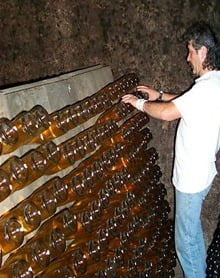 bottle (as in the photo on the right). The yeast helps to perform a second fermentation in the bottle. This secondary fermentation can last a couple of years.
bottle (as in the photo on the right). The yeast helps to perform a second fermentation in the bottle. This secondary fermentation can last a couple of years.
6. After the yeast cells have finished “doing their thing”, they must be removed from the bottle. This process starts with riddling. The bottles are slowly rotated in a riddling rack. This allows the sediment to slowly slide down into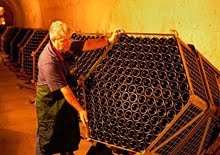 the neck of the bottle, for easy removal.
the neck of the bottle, for easy removal.
It used to be that riddling had to be done by hand, as the guy with the Mullet in the picture on the left is so aptly demonstrating. However they now have mechanical "gyro-palletes" (picture to the right) that handle the work.
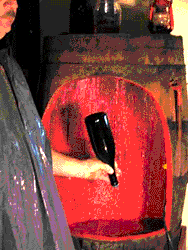 7. After riddling, the yeast flows into the neck of the bottle. The process of removing these dead yeast cells is called disgorging. The neck of the bottle is stuck into a machine, which freezes it. When the cap is removed, the frozen yeast shoots out along with a little wine.This is loosely illustrated by the series of rotating pictures on the left, however this step is now done by machines.
7. After riddling, the yeast flows into the neck of the bottle. The process of removing these dead yeast cells is called disgorging. The neck of the bottle is stuck into a machine, which freezes it. When the cap is removed, the frozen yeast shoots out along with a little wine.This is loosely illustrated by the series of rotating pictures on the left, however this step is now done by machines.
8. To replace the wine lost during disgorging, a special mix of sugar and aged wine called dosage is added to the bottle. The amount of sugar depends on the intended sweetness level of the Champagne style of wine: Brut has very little or no sugar 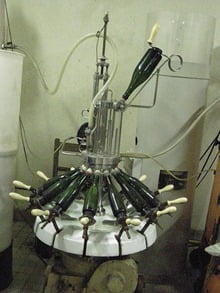 added, Extra-dry is a bit sweeter. Demi-sec and sec are progressively much sweeter.
added, Extra-dry is a bit sweeter. Demi-sec and sec are progressively much sweeter.
9. The bottle is then corked with the standard, large Champagne cork. Champagne and sparkling wine have a wire cage holding the cork in the bottle. Without this cage, corks would obviously fly off due of the pressure inside the bottles.
It’s worth noting that sparkling wine made in “Méthode Champenoise”, bears bubbles which are usually more  integrated into the wine and longer lasting. Also, because of the additional time the wine has spent in contact with its sediment during secondary fermentation, the yeast flavors add complexity and a creaminess to the wine that is not present in the cheaper methods of sparkling wine production.
integrated into the wine and longer lasting. Also, because of the additional time the wine has spent in contact with its sediment during secondary fermentation, the yeast flavors add complexity and a creaminess to the wine that is not present in the cheaper methods of sparkling wine production.
The term most often used for labeling sparkling wines not from the Champagne region of France, yet using the "Champagne Method" i.e. fermentation in the bottle, is Méthode Traditionnelle.










